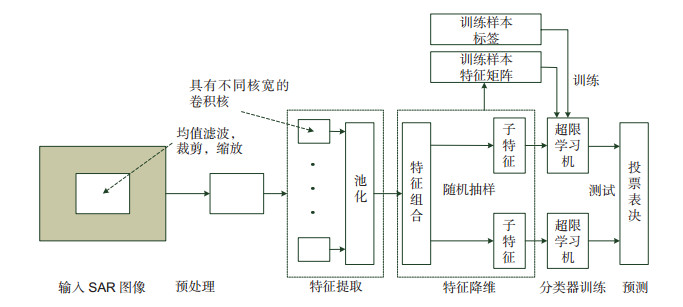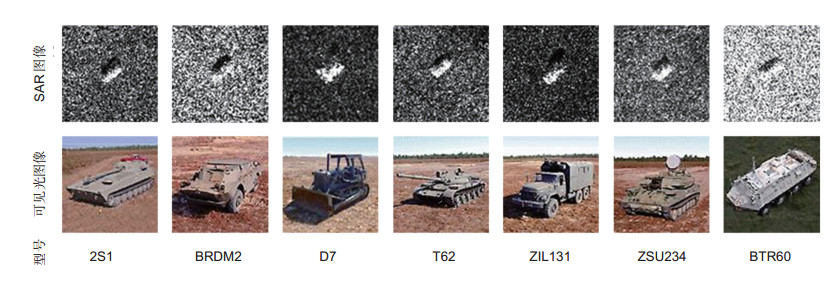Fast SAR target recognition based on random convolution features and ensemble extreme learning machines
-
摘要:
深度卷积神经网络在目标检测与识别等方面表现出了优异性能,但将其用于SAR目标识别时,较少的训练样本和深度模型的优化设计是必须解决的两个问题。本文设计了一种结合二维随机卷积特征和集成超限学习机的SAR目标识别算法。首先,随机生成具有不同宽度的二维卷积核,对输入图像进行卷积与池化操作,提取随机卷积特征向量。其次,为提高分类器的泛化能力,并降低训练时间,基于集成学习思想对提取的卷积特征进行随机采样,然后采用超限学习机训练基分类器。最后,通过投票表决法对基分类器的分类结果进行集成。采用MSTAR数据集进行了SAR目标识别实验,实验结果表明,由于采用的超限学习机具有快速训练能力,训练时间降低了数十倍,在无需进行数据增强的情况下,分类精度与采用数据增强和多层卷积神经网络的深度学习算法相当。提出的算法具有实现简单、需要调整参数少等优点,采用集成学习思想提高了分类器的泛化能力。
Abstract:Deep convolution neural network has demonstrated excellent performance in target detection and recognition tasks. However, few training samples and optimization design of deep models are two main problems to be solved when applied to SAR target recognition. This paper proposes an algorithm for SAR target recognition by combination of two dimensional random convolution features and ensemble extreme learning machines. Firstly, two dimensional random convolution kernels with different widths are generated, and convolution and pooling operations are performed in input image to extract random convolution feature vectors. Secondly, random samplings based on ensemble learning theory are done for extracted feature vectors to improve generalization performance of classifier and reduce training time, and base classifiers are then trained by extreme learning machines (ELM). Finally, majority vote method is adopted to combine the classification results of base classifiers. SAR target recognition experiments based on MSTAR database were performed, and experimental results demonstrate that, training time has dropped by ten times due to fast training capability of ELM, and the proposed algorithm achieves comparable classification performance with deep-learning-based methods which use data augmentation and multiple convolution layers. The proposed algorithm has the advantages of easy implementation and fewer adjustable parameters, and improves classifier's generalization performance through adoption of ensemble learning ideas.
-
Key words:
- deep learning /
- convolution features /
- randomization /
- extreme learning machine /
- ensemble learning
-

Abstract: Deep convolution neural network has demonstrated excellent performance in target detection and recognition tasks, however, few training samples and optimization design of deep models are two main problems to be solved when applied to SAR target recognition. This paper proposes a fast SAR target recognition algorithm by combination of two dimensional random convolution features and ensemble extreme learning machines. Firstly, two dimensional random convolution features are extracted, where kernel widths are randomly selected from the kernel width set, and random kernels with different widths are generated based on uniform distribution. Convolution and square pooling operations are performed in the input image to extract random convolution features, and these features are transformed into vectors and combined to form a high-dimensional feature vector. Secondly, random sampling operations based on ensemble learning theory are adopted to perform dimensionality dimension to get a low-dimensional feature vector, and extreme learning machines (ELM), which has the advantages of fast training speed, few adjustable parameters, and good generalization performance, are used to train base classifiers. Finally, majority vote method is adopted to combine the classification results of base classifiers to predict the label of the targets. MSTAR database is used to perform SAR target recognition experiments to verify the performance of the proposed algorithm. The parameters which affect recognition performance greatly are firstly analyzed, including the number of the convolution kernel, the width of the convolution kernel, the number of base classifier, and regularization parameter. It can be concluded that, recognition performance with larger kernel width is higher than that with smaller kernel width, where convolution kernels with small width, such as 3×3, is mostly often used in deep convolution models to perform visible image recognition. Extreme learning machine with small regularization coefficient can achieve good generalization capability and improve recognition performance. SAR target recognition experiments are done under standard operating condition and extended operating conditions, and experimental results demonstrate that, the overall recognition performances for ten-class targets with and without distorted configurations are 95.79% and 97.57%, respectively. Meanwhile, the training time has dropped by ten times due to fast training capability of ELM, and the proposed algorithm achieves comparable classification performance with deep-learning-based methods which use data augmentation and multiple convolution layers. Finally, the recognition performance compared with state-of-the-art classifiers are presented. The proposed algorithm has the advantages of easy implementation and fewer adjustable parameters, and improves classifier’s generalization performance through adoption of ensemble learning ideas.
-

-
表 1 MSTAR数据集描述
Table 1. Description of MSTAR database
目标类型 2S1 BRDM2 D7 T62 ZIL
131ZSU234 BTR60 BMP2 BTR70 T72 SN9563 SN9566 SNC21 SNC71d SN132 SN812 SNS7 训练样本数 299 298 299 299 299 299 256 233 / / 233 232 / / 测试样本数 274 274 274 273 274 274 195 195 196 196 196 196 195 191 表 2 正则化系数λ对分类精度的影响
Table 2. Influence of regularization parameter λ on classification performance
λ AA/% OA/% 0.01 97.53 97.44 0.1 97.49 97.28 1 95.32 90.68 10 91.30 90.17 100 88.99 88.29 表 3 集成分类器数目对分类精度的影响
Table 3. Influence of number of ensemble classifiers on classifcation performance
分类器数目 AA/% OA/% 1 96.08 95.71 2 97.52 97.32 4 97.66 97.53 6 97.64 97.48 8 97.62 97.53 10 97.49 97.48 表 4 卷积核宽度对分类精度的影响
Table 4. Influence of convolution kernel width on classification performance
宽度 AA/% OA/% 3 92.06 92.58 5 96.82 96.82 7 97.63 97.61 9 97.91 97.77 11 97.78 97.69 13 97.73 97.57 表 5 10类目标分类混淆矩阵(文献[12]配置)
Table 5. Confusion matrix for classifcation of target with ten classes (Ref[12]'s confguration)
类别 2S1 BRDM2 D7 T62 ZIL131 ZSU234 BTR60 BMP2 BTR70 T72 No. 正确率/% 2S1 266 0 0 3 0 0 1 1 2 1 274 97.08 BRDM2 0 252 0 0 6 0 1 0 12 3 274 91.97 D7 1 1 272 0 0 0 0 0 0 0 274 99.27 T62 1 0 0 268 0 0 0 0 2 2 273 98.17 ZIL131 0 0 0 0 273 1 0 0 0 0 274 99.64 ZSU234 0 0 3 1 0 269 0 0 0 1 274 98.18 BTR60 0 2 0 2 1 0 190 0 0 0 195 97.44 BMP2 0 0 0 0 0 0 0 189 3 4 195 96.43 BTR70 0 0 0 0 0 0 0 0 196 0 196 100 T72 0 0 0 0 0 0 0 3 1 192 196 97.96 AA 97.61 OA 97.57 表 6 10类目标分类混淆矩阵(文献[11]配置)
Table 6. Confusion matrix for classifcation of target with ten classes (Ref[11]'s confguration)
类别 2S1 BRDM2 D7 T62 ZIL131 ZSU234 BTR60 BMP2 BTR70 T72 No. 正确率/% 2S1 267 0 0 4 0 0 0 2 1 0 274 97.45 BRDM2 3 256 2 0 3 0 0 1 6 3 274 93.43 D7 1 0 272 0 0 0 0 0 1 0 274 99.27 T62 0 0 0 270 0 0 0 0 0 3 273 98.90 ZIL131 0 0 0 0 271 0 0 1 1 1 274 98.91 ZSU234 0 0 2 2 0 270 0 0 0 0 274 98.54 BTR60 0 4 0 2 0 0 189 0 0 0 195 96.92 BMP2 0 0 0 0 0 0 0 525 23 39 587 89.44 BTR70 0 0 0 0 0 0 0 0 196 0 196 100 T72 0 0 0 0 0 0 0 21 9 552 582 94.85 AA 96.77 OA 95.79 表 7 与基于深度卷积神经网络的SAR目标识别算法性能比较
Table 7. Comparison of target recognition performance between the proposed algorithm and deep-learning-based algorithm
表 8 EOC-1条件下分类混淆矩阵
Table 8. Confusion matrix for EOC-1
类别 型号 俯视角/° 数量 BMP2 BRDM2 T72 BTR70 正确率/% T72 S7 15, 17 419 12 0 389 18 92.84 A32 15, 17 572 16 54 488 14 85.31 A62 15, 17 573 1 33 528 11 92.15 A63 15, 17 573 5 55 501 12 87.43 A64 15, 17 573 34 63 422 54 73.65 AA 86.28 OA 85.90 表 9 EOC-2条件下分类混淆矩阵
Table 9. Confusion matrix for EOC-2
类别 数量 2S1 BRDM2 T72 ZSU234 正确率/% 2S1 288 272 11 0 5 94.44 BRDM2 287 19 268 0 0 93.38 T72 288 65 54 153 16 53.13 ZSU234 288 4 6 1 277 96.18 AA 84.28 OA 84.27 表 10 不同分类算法的分类性能比较
Table 10. Comparison of average classifcation accuracies for different classifcation algorithms
-
[1] El-darymli K, Gill E W, Mcguire P, et al. Automatic target recognition in synthetic aperture radar imagery: a state-of-the-art review[J]. IEEE Access, 2016, 4: 6014–6058. doi: 10.1109/ACCESS.2016.2611492
[2] Pei J F, Huang Y L, Huo W B, et al. SAR imagery feature extraction using 2DPCA-based two-dimensional neighborhood virtual points discriminant embedding[J]. IEEE Journal of Selected Topics in Applied Earth Observations and Remote Sensing, 2016, 9(6): 2206–2214. doi: 10.1109/JSTARS.2016.2555938
[3] Amoon M, Rezai-Rad G A. Automatic target recognition of synthetic aperture radar (SAR) images based on optimal selection of Zernike moments features[J]. IET Computer Vision, 2014, 8(2): 77–85. doi: 10.1049/iet-cvi.2013.0027
[4] Du P J, Samat A, Gamba P, et al. Polarimetric SAR image classification by boosted multiple-kernel extreme learning machines with polarimetric and spatial features[J]. International Journal of Remote Sensing, 2014, 35(23): 7978–7990. doi: 10.1080/2150704X.2014.978952
[5] Zhao Q, Principe J C. Support vector machines for SAR automatic target recognition[J]. IEEE Transactions on Aerospace and Electronic Systems, 2001, 37(2): 643–654. doi: 10.1109/7.937475
[6] Sun Y J, Liu Z P, Todorovis S, et al. Adaptive boosting for SAR automatic target recognition[J]. IEEE Transactions on Aerospace and Electronic Systems, 2007, 43(1): 112–125. doi: 10.1109/TAES.2007.357120
[7] Song S L, XU B, Yang J. SAR target recognition via supervised discriminative dictionary learning and sparse representation of the SAR-HOG feature[J]. Remote Sensing, 2016, 8(8): 683. http://adsabs.harvard.edu/abs/2016RemS....8..683S
[8] Zhang H C, Nasrabadi N M, Zhang Y N, et al. Multi-view automatic target recognition using joint sparse representation[J]. IEEE Transactions on Aerospace and Electronic Systems, 2012, 48(3): 2481–2497. doi: 10.1109/TAES.2012.6237604
[9] Dong G G, Kuang G Y, Wang N, et al. SAR target recognition via joint sparse representation of monogenic signal[J]. IEEE Journal of Selected Topics in Applied Earth Observations and Remote Sensing, 2015, 8(7): 3316–3328. doi: 10.1109/JSTARS.2015.2436694
[10] Hinton G E, Salakhutdinov R R. Reducing the dimensionality of data with neural networks[J]. Science, 2006, 313 (5786): 504–507. doi: 10.1126/science.1127647
[11] Ding J, Chen B, Liu H W, et al. Convolutional neural network with data augmentation for SAR target recognition[J]. IEEE Geoscience and Remote Sensing Letters, 2016, 13(3): 364–368. https://www.researchgate.net/publication/292075615_Convolutional_Neural_Network_With_Data_Augmentation_for_SAR_Target_Recognition
[12] Chen S Z, Wang H P, Xu F, et al. Target classification using the deep convolutional networks for SAR images[J]. IEEE Transactions on Geoscience and Remote Sensing, 2016, 54(8): 4806–4817. doi: 10.1109/TGRS.2016.2551720
[13] Huang G, Huang G B, Song S J, et al. Trends in extreme learning machines: a review[J]. Neural Networks, 2015, 61: 32–48. doi: 10.1016/j.neunet.2014.10.001
[14] Rokach L. Ensemble-based classifiers[J]. Artificial Intelligence Review, 2010, 33(1–2): 1–39. doi: 10.1007/s10462-009-9124-7
[15] Goodfellow I, Bengio Y, Courville A. Deep Learning[M]. Cambridge, USA: MIT Press, 2016.
[16] Iamdola F N, Han S, Moskewica M W, et al. SqueezeNet: AlexNet-level accuracy with 50x fewer parameters and < 0. 5MB model size[EB/OL]. arXiv preprint: 1602.07360, 2016.
[17] Huang G B, Bai Z, Kasun L L C, et al. Local receptive fields based extreme learning machine[J]. IEEE Computational Intelligence Magazine, 2015, 10(2): 18–29. doi: 10.1109/MCI.2015.2405316
[18] 李铁, 张新君.极限学习机在高光谱遥感图像分类中的应用[J].光电工程, 2016, 43(11): 62–68. doi: 10.3969/j.issn.1003-501X.2016.11.010 http://www.oee.ac.cn/CN/abstract/abstract1831.shtml
Li T, Zhang X J. Research of hyperspectral remote sensing image classification based on extreme learning machine[J]. Opto-Electronic Engineering, 2016, 43(11): 62–68. doi: 10.3969/j.issn.1003-501X.2016.11.010 http://www.oee.ac.cn/CN/abstract/abstract1831.shtml
[19] Breiman L. Bagging predictors[J]. Machine Learning, 1996, 24(2): 123–140. https://link.springer.com/article/10.1023/A:1018054314350
[20] 倪维平, 严卫东, 吴俊政, 等. MSTAR图像2D Gabor滤波增强与自适应阈值分割[J].光电工程, 2013, 40(3): 87–93. http://www.oee.ac.cn/CN/abstract/abstract519.shtml
Ni W P, Yan W D, Wu J Z, et al. 2D gabor filter enhancing and adaptive thresholding for MSTAR image[J]. Opto-Electronic Engineering, 2013, 40(3): 87–93. http://www.oee.ac.cn/CN/abstract/abstract519.shtml
[21] Srinivas U, Monga V, Raj R G. SAR automatic target recognition using discriminative graphical models[J]. IEEE Transactions on Aerospace and Electronic Systems, 2014, 50(1): 591–606. doi: 10.1109/TAES.2013.120340
-


 E-mail Alert
E-mail Alert RSS
RSS

 下载:
下载:




